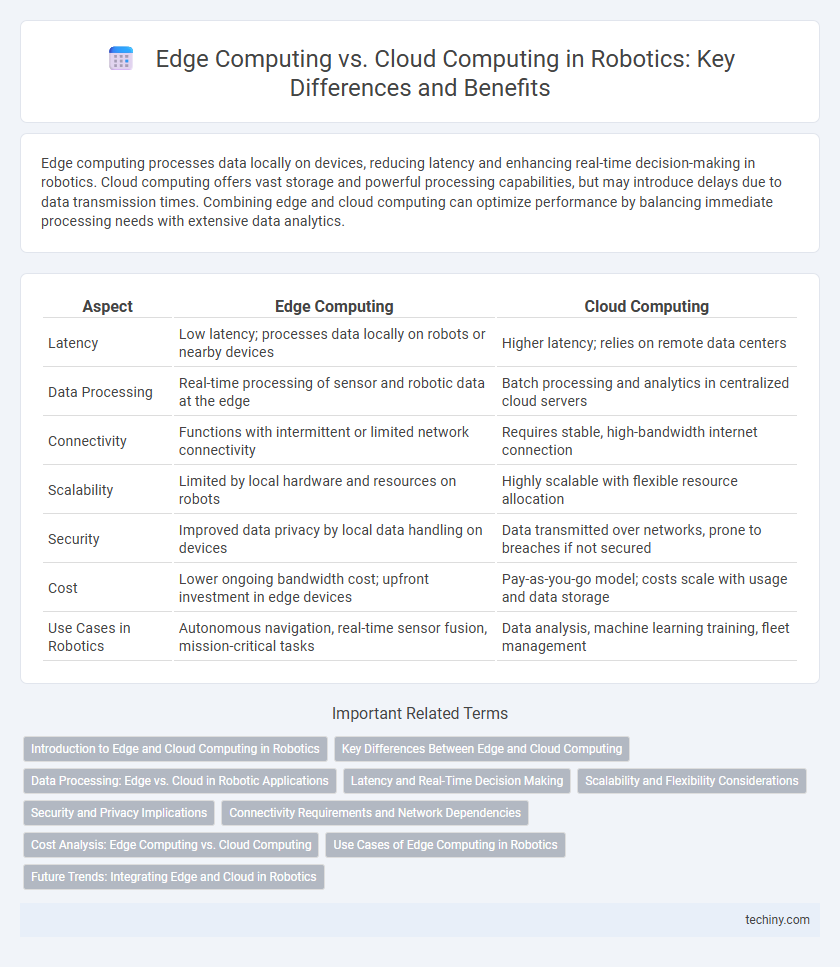Edge computing processes data locally on devices, reducing latency and enhancing real-time decision-making in robotics. Cloud computing offers vast storage and powerful processing capabilities, but may introduce delays due to data transmission times. Combining edge and cloud computing can optimize performance by balancing immediate processing needs with extensive data analytics.
Table of Comparison
| Aspect | Edge Computing | Cloud Computing |
|---|---|---|
| Latency | Low latency; processes data locally on robots or nearby devices | Higher latency; relies on remote data centers |
| Data Processing | Real-time processing of sensor and robotic data at the edge | Batch processing and analytics in centralized cloud servers |
| Connectivity | Functions with intermittent or limited network connectivity | Requires stable, high-bandwidth internet connection |
| Scalability | Limited by local hardware and resources on robots | Highly scalable with flexible resource allocation |
| Security | Improved data privacy by local data handling on devices | Data transmitted over networks, prone to breaches if not secured |
| Cost | Lower ongoing bandwidth cost; upfront investment in edge devices | Pay-as-you-go model; costs scale with usage and data storage |
| Use Cases in Robotics | Autonomous navigation, real-time sensor fusion, mission-critical tasks | Data analysis, machine learning training, fleet management |
Introduction to Edge and Cloud Computing in Robotics
Edge computing in robotics enables real-time data processing by deploying computational resources near sensors and actuators, reducing latency and improving responsiveness. Cloud computing offers centralized processing power and vast storage capabilities, facilitating complex machine learning model training and large-scale data analysis for robotic systems. Combining both approaches enhances robot autonomy, allowing local decision-making while leveraging cloud resources for advanced analytics and updates.
Key Differences Between Edge and Cloud Computing
Edge computing processes data locally on robotic devices or nearby edge servers, minimizing latency and enabling real-time decision-making essential for autonomous robots. Cloud computing relies on centralized data centers, offering vast storage and computational power but introduces latency that can hinder immediate response. Key differences include proximity to data sources, latency levels, bandwidth usage, and dependency on continuous internet connectivity.
Data Processing: Edge vs. Cloud in Robotic Applications
Edge computing processes data locally on robots, enabling real-time decision-making and reducing latency in critical robotic applications. Cloud computing centralizes data processing, offering vast computational resources for complex analytics and machine learning tasks but introduces higher latency and dependency on network connectivity. The hybrid approach leverages edge for immediate actions and cloud for extensive data analysis, optimizing performance and efficiency in robotics.
Latency and Real-Time Decision Making
Edge computing reduces latency by processing data locally on robotic devices or nearby edge servers, enabling faster real-time decision making critical for autonomous navigation and immediate sensor feedback. Cloud computing, while offering extensive computational resources, introduces higher latency due to data transmission delays, making it less suitable for time-sensitive robotic tasks. Optimizing robotics applications often involves a hybrid approach where latency-sensitive processes leverage edge computing, and complex analytics utilize cloud resources.
Scalability and Flexibility Considerations
Edge computing enhances scalability in robotics by processing data locally, reducing latency and bandwidth usage compared to cloud computing. Cloud computing offers greater flexibility through centralized resource pooling and easy deployment of updates across multiple robotic systems. Combining edge and cloud solutions enables scalable, adaptable robotics operations that balance real-time performance with extensive computational power.
Security and Privacy Implications
Edge computing enhances security in robotics by processing data locally, minimizing the exposure of sensitive information to external networks and reducing latency-related vulnerabilities. Cloud computing offers scalable resources but increases risks of data breaches due to centralized storage and transmission over potentially insecure networks. Implementing robust encryption and access control mechanisms is critical in both edge and cloud models to safeguard robotic systems from cyber threats and ensure privacy compliance.
Connectivity Requirements and Network Dependencies
Edge computing in robotics demands low-latency, reliable connectivity to process data near the source, minimizing reliance on constant network availability and reducing bandwidth usage. Cloud computing depends heavily on stable, high-speed internet connections to transmit vast amounts of sensor data for centralized processing and storage, making robotic systems vulnerable to network interruptions. Hybrid models leverage edge computing for critical, time-sensitive tasks while utilizing cloud resources for complex analytics, balancing connectivity requirements and network dependencies effectively.
Cost Analysis: Edge Computing vs. Cloud Computing
Edge computing in robotics reduces latency and bandwidth costs by processing data locally, minimizing reliance on expensive cloud resources. Cloud computing offers scalable storage and powerful processing but incurs ongoing expenses tied to data transmission and centralized server use. Analyzing total cost of ownership reveals edge computing's advantage in environments requiring real-time responsiveness and reduced operational expenses.
Use Cases of Edge Computing in Robotics
Edge computing in robotics enables real-time data processing for autonomous navigation, reducing latency and improving decision-making in dynamic environments. It enhances robotic applications such as predictive maintenance, where immediate analysis of sensor data prevents failures without relying on cloud connectivity. Use cases include collaborative robots (cobots) on factory floors that process tasks locally to ensure safety and responsiveness while minimizing data transmission delays.
Future Trends: Integrating Edge and Cloud in Robotics
Future trends in robotics emphasize the seamless integration of edge computing and cloud computing to enhance processing capabilities and real-time decision-making. Edge computing enables robots to process data locally for low-latency tasks, while cloud computing provides extensive computational power and large-scale data storage. Combining these technologies supports advanced applications such as autonomous navigation, predictive maintenance, and collaborative multi-robot systems by leveraging both immediate responsiveness and centralized intelligence.
Edge computing vs Cloud computing Infographic

 techiny.com
techiny.com